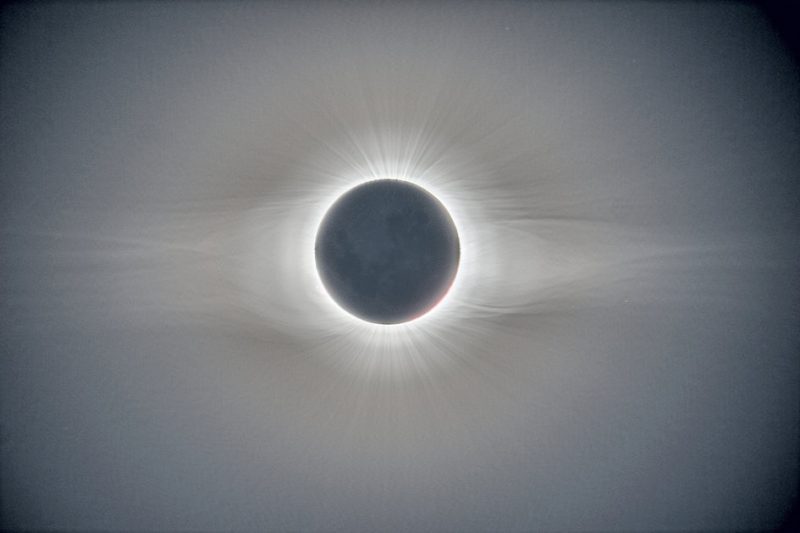
Also, check out Eliot Herman’s images. He caught the July 2, 2019 eclipse from La Serena, Chile.

This composite image captures the drama of totality during the July 2, 2019 total solar eclipse. When – as seen from Earth – the moon passes directly in front of the sun, the sun’s light is blocked and its extended atmosphere or corona can be seen. The processing of this image highlights the intricate detail of the corona, its structures shaped by the sun’s magnetic field. Some details of the lunar surface can also be seen. The image was created by the ESA-CESAR team observing the eclipse from ESO’s La Silla Observatory in Chile, South America. Image ESA/ CESAR/ Observatorio Astrofisico di Torino.

A prominence seen in the sun’s chromosphere during the July 2, 2019 total solar eclipse. Prominences are made of tangled magnetic field lines that keep dense concentrations of solar plasma suspended above the sun’s surface. They are anchored to the sun’s visible surface and extend outwards through the chromosphere and out into the corona. The red hue of the chromosphere is only apparent during an eclipse. This image – via ESA – was taken by the ESA-CESAR team observing the eclipse from ESO’s La Silla Observatory in Chile, South America.
While some observers on the southern part of Earth saw a total solar eclipse, the European Space Agency’s Proba-2 satellite’s SWAP imager in space saw a partial eclipse, as shown in the video below. The images are in ultraviolet light, revealing the turbulent nature of the sun’s surface and corona. ESA said:
During this eclipse the satellite was passing through the South Atlantic Anomaly at the time of the largest occultation [covering of the sun]. In this region the spacecraft is exposed to higher levels of radiation. The increased flux of energetic particles falling on the satellite’s detector is the cause for all the bright dots and streaks in the images.

This image of watchers from Yuri Beletsky the Chilean coast was chosen as an Astronomy Photo of the Day for July 4, 2019. Note that diffraction spikes are from the camera lens aperture.
Bottom line: More amazing images of the July 2, 2019 total solar eclipse.
from EarthSky https://ift.tt/30egsjL

Also, check out Eliot Herman’s images. He caught the July 2, 2019 eclipse from La Serena, Chile.

This composite image captures the drama of totality during the July 2, 2019 total solar eclipse. When – as seen from Earth – the moon passes directly in front of the sun, the sun’s light is blocked and its extended atmosphere or corona can be seen. The processing of this image highlights the intricate detail of the corona, its structures shaped by the sun’s magnetic field. Some details of the lunar surface can also be seen. The image was created by the ESA-CESAR team observing the eclipse from ESO’s La Silla Observatory in Chile, South America. Image ESA/ CESAR/ Observatorio Astrofisico di Torino.

A prominence seen in the sun’s chromosphere during the July 2, 2019 total solar eclipse. Prominences are made of tangled magnetic field lines that keep dense concentrations of solar plasma suspended above the sun’s surface. They are anchored to the sun’s visible surface and extend outwards through the chromosphere and out into the corona. The red hue of the chromosphere is only apparent during an eclipse. This image – via ESA – was taken by the ESA-CESAR team observing the eclipse from ESO’s La Silla Observatory in Chile, South America.
While some observers on the southern part of Earth saw a total solar eclipse, the European Space Agency’s Proba-2 satellite’s SWAP imager in space saw a partial eclipse, as shown in the video below. The images are in ultraviolet light, revealing the turbulent nature of the sun’s surface and corona. ESA said:
During this eclipse the satellite was passing through the South Atlantic Anomaly at the time of the largest occultation [covering of the sun]. In this region the spacecraft is exposed to higher levels of radiation. The increased flux of energetic particles falling on the satellite’s detector is the cause for all the bright dots and streaks in the images.

This image of watchers from Yuri Beletsky the Chilean coast was chosen as an Astronomy Photo of the Day for July 4, 2019. Note that diffraction spikes are from the camera lens aperture.
Bottom line: More amazing images of the July 2, 2019 total solar eclipse.
from EarthSky https://ift.tt/30egsjL

Aucun commentaire:
Enregistrer un commentaire